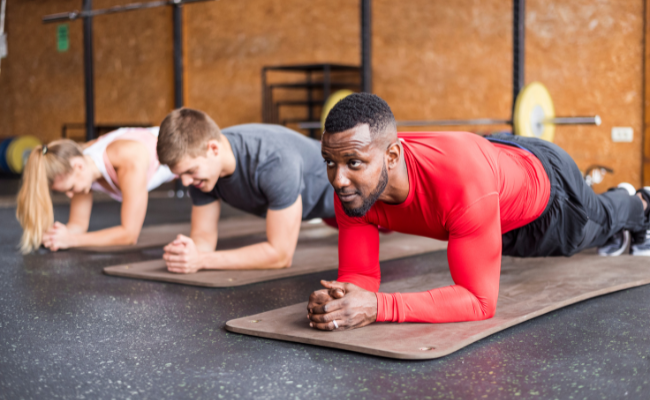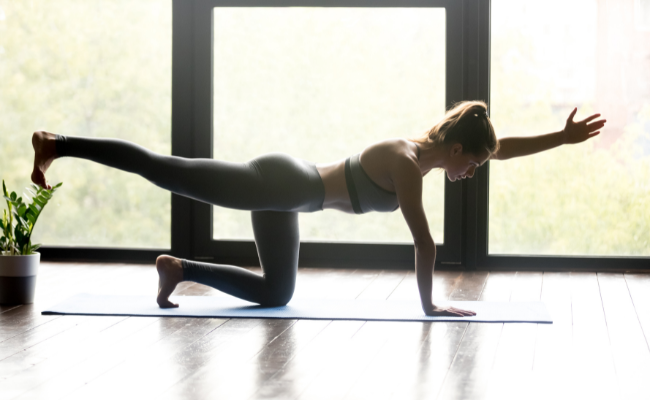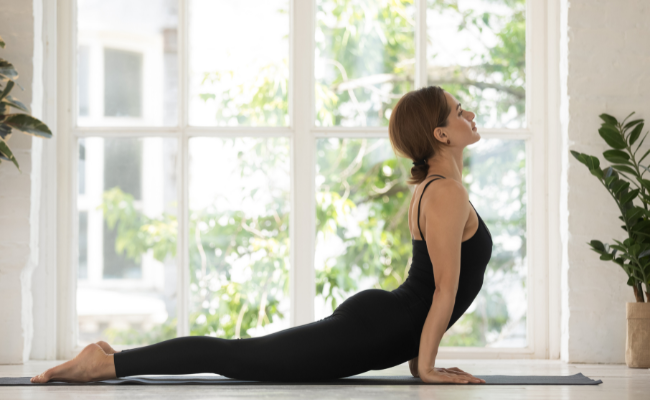Maintaining good back health and posture is crucial for overall well-being. Poor posture can cause pain and discomfort and reduce productivity and quality of life.
Back exercises can help strengthen the muscles supporting the spine. You also improve posture, balance, flexibility and mobility, reduce pain and enhance physical performance.
Back exercises with no equipment utilizing body weight as resistance is perfect for people who want to work out at home. These seven bodyweight exercises are especially beneficial if you don’t want to pay for costly gym memberships or specialized equipment.
1. Plank
 The plank is the poster child of back exercises with no equipment. The plank is an effective way to strengthen your core muscles and test your stability. Even though it’s not a cardio exercise, it engages various muscles, increasing your calorie burn.
The plank is the poster child of back exercises with no equipment. The plank is an effective way to strengthen your core muscles and test your stability. Even though it’s not a cardio exercise, it engages various muscles, increasing your calorie burn.
To perform a plank, choose a comfortable position to extend your entire body length. Use an exercise mat for ample padding on all fours, either on your palms or forearms.
- Begin by facing down with your forearms and toes on the ground. Direct your elbows under your shoulders and face your forearms forward.
- Relax your head and look at the floor. Engage your core muscles by drawing your navel towards your spine. Maintain a straight, rigid torso without bending or sagging.
- Your shoulders should not creep up toward your ears, and your heels should be over the balls of your feet.
- Hold this position for at least 10 seconds before releasing it to the floor.
- Gradually increase the duration to 30, 45, or 60 seconds.
Try out modified plank exercises like the side plank and plank jacks. These variations engage different muscle groups, making the workout more challenging and effective.
2. Superman
The Superman is another exercise you perform on the floor. With no equipment, you’ll need ample space and a soft, clean mat to perform this back exercise.
- Lie face down on the floor with your arms extended in front and legs straight.
- Lift your arms and legs about 6 inches off the ground, engaging your lower back, glutes, core, and shoulder blades.
- Contract your abs by lifting your belly button slightly off the floor.
- Hold for 2–3 seconds and breathe.
- Lower your limbs and repeat for 2–3 sets of 8–12 reps.
- Lift your body to a comfortable level. A few inches off the floor still works. If it’s difficult, lift only your arms. Don’t hyperextend your neck.
The Superman exercise has numerous benefits, including spinal support, improved posture, injury prevention, stronger glutes and hamstrings, and flexibility. Doing the Superman exercise is an excellent addition to any fitness routine.
Beginners can also modify the exercise by only lifting the upper or lower body at a time. To increase the difficulty, add weights or hold the position for longer.
You may also like: Lower Ab Workouts Dream Body
3. Bird Dog

Like the first two back exercises, you need ample space and a mat for this. Place a flat cushion or folded towel under your knees to avoid bruising.
- Position yourself on the floor on all fours. Align your knees under your hips, and place your hands under your shoulders.
- Engage your abdominal muscles to maintain a neutral spine. Draw your shoulder blades together.
- Lift your right arm and left leg, ensuring your shoulders and hips remain parallel to the floor.
- Lengthen the back of your neck. Keep your eyes toward the floor by tucking your chin into your chest.
- Maintain this pose for a few seconds and then return to the starting position.
- Repeat the steps with your left arm and right leg to complete one rep.
Focus on moving your body as a whole for full benefits. It teaches abdominal engagement and stabilizes your lower back, leading to greater ease and mobility in daily and athletic movements.
Beginners can also try lifting the opposite arm and leg. As you become more comfortable, you can add resistance bands or weights, perform a plank, and alternate between different variations.
4. Bridge
The bridge exercise strengthens the back and glute bridge, improving posture, reducing lower back pain, and enhancing athletic performance. It engages core muscles to improve stability and balance.
Performing the bridge exercise can strengthen your back and glutes and improve core stability. Follow these steps to do it correctly:
- Lie on your back with your knees bent and feet flat.
- Keep your glutes and core engaged. Lift your hips towards the ceiling. Form a straight line from your shoulders to your knees.
- Hold a few seconds while you bend your knees, then lower your hips. Repeat for several reps.
For a greater challenge, lift one leg, add resistance bands or weights, or hold the bridge for a few minutes. Beginners can perform the exercise with a yoga block or ball under the lower back.
You may also like: Advance Yoga Poses Avery Beginner Should Challenge Themselves to Hit
5. Wall Angels
This exercise improves T-spine mobility, benefitting the mid-to-upper spine. Wall angels are an excellent pre-workout move. This exercise can help loosen up the T-spine for squat positions, overhead presses, etc.
Mastering this exercise enhances your posture and teaches you to retract your shoulders while avoiding an arched back. Follow these steps to perform wall angels and strengthen your spinal mobility:
- Sit tall against a wall, and create a 90-degree angle with your body.
- Press your entire back against the wall, including your natural arch. Straighten your legs in front of you.
- Bring your elbows out to the side, in line with your shoulders. Push your triceps against the wall.
- Rotate your arms upward. Your forearms and the back of your hands also touch the wall, mimicking the shape of a football goalpost.
- Raise your arms gradually above your head, extending your shoulders and elbows fully. Keep pressing your back into the wall and avoid arching or losing contact with it.
- Lower your arms back down until your triceps are parallel to the ground.
- Repeat this movement for 10–15 reps.
If you struggle to maintain a neutral spine position, opt for floor angels, single-arm walls, or floor angels.
6. Cobra

How you start a cobra pose is dependent on your stance. Otherwise, you can lie on your stomach with your palms facing the ground beneath your shoulders.
- Hug your elbows into your sides. Look down at the mat with your neck in a neutral position.
- Lift your chest off the ground when you inhale, rolling your shoulders back. Keep your lower ribs and hands on the floor.
- Ensure your elbows stay close to your sides.
- Keep your gaze on the ground. Exhale as you return to the original position. You can push up to a downward-facing dog if you’re practicing a sun salutation.
Regular practice of the cobra pose in Hatha yoga may alleviate mild depression symptoms and enhance relaxation. Studies suggest that yoga, including cobra pose, can reduce inflammation, boost mood, and improve sleep, especially in women.
7. Wall Slides
Wall slides are a dependable way to improve upper back strength and posture. This move works by standing with your feet against a wall and then swinging your arms up and down the wall. Remember to always keep your elbows, wrists, and hands in contact with the wall.
This exercise can help improve upper back strength. It also enhances shoulder mobility and promotes better posture by strengthening the upper back and shoulder muscles. Adding wall slides to your routine counters the effects of sitting and slouching, which can lead to poor posture and pain.
- Stand with your back against the wall, feet shoulder-width apart, and arms at your sides.
- Slowly slide your arms up the wall until your elbows are at shoulder height.
- Hold for a few seconds, then slowly slide your arms back down.
Related Articles
For beginners, start with a smaller range of motion. Focus on keeping the elbows, wrists, and hands in contact with the wall. As you become more comfortable, you can increase your range of motion. You can also add resistance by holding a light weight in each hand.
For advanced users, perform the exercise on one leg or use a resistance band to add more tension.
Conclusion
Back exercises without equipment can improve strength, flexibility, and heart rate fitness. Plus, they can be done anywhere and anytime, making them a convenient and cost-effective way to stay active.
Staying fit and keeping in shape is in your hands. With these bodyweight workouts, you do not have an excuse not to exercise. Incorporate these routines into your daily activities. Your body will thank you later.

